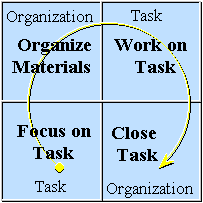Note: This site is moving to KnowledgeJump.com. Please reset your bookmark.
Time Management Activity

1. Have the learners read the Time Management Model below. Also, note they will need to read the section on The Big Rocks of Time (about 5 min.).
2. Break them into small groups composed of 2 to 4 learners. Have them discuss what they have just read (about 10 min.).
3. The learners will now work alone. Ensure each person has a pen and paper. Have them divided the paper into two columns: Life and Work. Ask them to list their most important priorities in the respective column. If a priority spans both columns, then have them draw a line into the next column to show the priority is both a life and work priority (about 15 to 20 min.).
4. The learners should join their previous group (or you can create new small groups) and discuss their lists with each other (about 25 min.):
- Will the items that span both columns be easier or more difficult to accomplish?
- How will you handle the items that might contradict each other? For example, one item is to spend more time with family, while another item is to work harder to be promoted.
- Which column contains the most items and which one contains the most important items? Why?
- What must you do to ensure the big priorities get accomplished?
Reading Material: Time Management Model
The ability to manage time normally takes two skills:
- Organization: the ability to organize tasks according to their priorities
- Task: the ability to focus on the task on hand
These two concepts form the x-axis and y-axis as shown in the model below:

This matrix has four types of people when it comes to time management:
- Perfectionists will often spend too much time arranging their priorities, but do not focus on the task at hand.
- Slobs are always in disarray because they fail to prioritize and do not focus on the task at hand.
- Doers focus on a task they are performing, but often fail to accomplish the important ones because they fail to prioritize.
- Time Managers both prioritize their tasks so that they know which ones need accomplished first and always focus on the task at hand.
We can also rearrange the two dimensions so that they show the four steps of good time management when performing a task:

- Focuses upon the task on hand to discover what needs to be accomplish.
- Organizes the materials so that the task can be accomplished.
- Uses the materials to get the task done
- Uses one's inner-abilities and instincts to wrap things up (know when to stop and what to finish) so that the next priority task can be started — don't waste time on the unimportant details.
In The Big Rocks of Time, Stephen Covey uses jars as a metaphor for the amount of time we have and rocks for the tasks that must be prioritized (the bigger the rock, the more important the task is). And just as a jar can only hold so many rocks, we only have so much time in a day to get the right things done, thus it is important that we decide which tasks are the big ones (the most important) to ensure they fit within our “time jar.”
Next Steps
This activity is based on the Time Management chapter
Return to the Leadership Training and Development Outline
